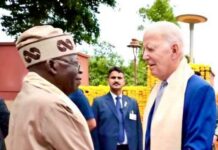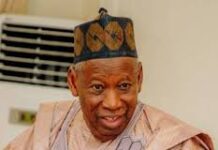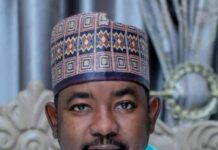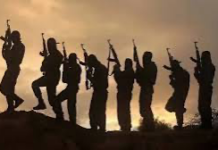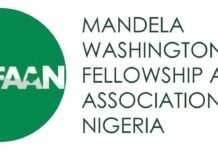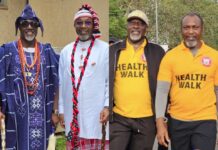New Presidential Aircraft, Branding and a Missed Opportunity
By Oluseye Adebayo
After weeks of anticipation, the pictures of the new presidential jet as presented in the media when President Tinubu was leaving Abuja for his visit to France on Monday, thec19th of August was a disappointing climax.
It shows that some people somewhere are either not doing enough thinking about the image they are presenting of the country and its current government. or are detached from the citizens as some people claim.
Years back when I worked around one of the big airports in the United kingdom that normally hosted aircrafts from our presidential fleet, it was always a thing of pride for Nigerians around the airport when we spotted aircrafts from our presidential fleet, with the bold seal of The President of the Federal Republic of Nigeria, or Nigeria Air Force and the distinctive green-white-green stripe. they served as a rallying call of pride and national unity.
Therefore, being the biggest aircraft so far to be used as NGR001, you can understand why I was looking forward to the projection of our national colours on the new acquisition.
However, the decision to leave the blue, brown and gold stripe on the recently purchased Airbus A330 with registration 5N-FGA, instead of the traditional green and white stripes associated with Nigeria, and the small writings and equally small size of the seal of the president on the aircraft is a missed opportunity to reaffirm the country’s identity on the global stage.
Making the aircraft look inconsequential like many of the wet leased aircrafts that dots airports around the world, instead of projecting the might of Nigeria, a faux pas as unthinkable and possibly on the same level as making a pink coloured Cadillac the presidential limousine.
The Importance of National Branding in Presidential Aircraft Branding is more than just colours or logos; it’s about the story you tell and the identity you convey.
For nations, especially those with a rich heritage and vibrant culture, the branding of assets such as presidential aircraft plays a crucial role in expressing national identity and pride.
One of the most iconic examples of effective national branding is the United States’ Air Force One. The blue, white, and gold design of Air Force One is instantly recognizable worldwide, symbolizing American power, pride, and tradition.
This iconic livery, designed during the Kennedy administration, isn’t just about aesthetics; it reinforces the image of the United States as a strong, unified nation.
Similarly, other countries have used their presidential aircraft as a means of projecting their national identity.
Japan’s Air Force One, with its red and white colors reflecting the country’s flag, and France’s blue, white, and red design, showcase how national symbols and colours play a critical role in aircraft branding. These designs are not arbitrary— they are deliberate choices that remind the world of the country the aircraft represents.
For Nigeria, the green and white colours are more than just hues, they are symbolic of the nation’s agricultural wealth and desire for peace. The green represents the country’s rich natural resources, while white symbolizes peace and unity.
Read Also:
These colours are widely recognized and resonate with both citizens and the international community as a representation of the Nigerian identity.
Presidential aircraft, such as Nigeria’s, serve as flying embassies. They carry the nation’s image wherever they go, whether it’s to international summits, state visits, or global events.
A plane bearing Nigeria’s green and white colours reinforces this identity, acting as a subtle yet powerful assertion of the country’s presence.
The blue, brown, and gold stripe currently adorning the Airbus A330, while elegant, doesn’t resonate with Nigeria’s national symbolism.
It appears generic and lacks the visual connection to the nation’s colours and values. For an asset as significant as a presidential aircraft, this is a missed chance to proudly display Nigeria’s identity.
Countries that invest in the branding of their presidential fleets understand that these aircrafts are more than just tools of transportation.
They are symbols of national pride and identity. By leaving the blue and gold stripe, Nigeria misses out on an opportunity to leverage this aircraft as a branding tool that celebrates its culture, history, and aspirations.
When considering the role of a national fleet in shaping international perception, it’s important to note how other countries integrate their cultural and national symbols into their branding:
1. United States (Air Force One): The distinct blue, white, and gold design of Air Force One is a deliberate statement of American strength, dignity, and history. The design is so effective that it is immediately recognized globally.
2. France: The French presidential aircraft features the blue, white, and red of the national flag, reinforcing France’s identity and history every time it lands in a foreign country.
3. India: The Indian presidential aircraft, with its saffron, white, and green colours, stays true to the national flag, reinforcing the country’s values of courage, peace, and faith.
In each of these examples, the aircraft is a canvas that proudly displays national values and identity. It’s not just a matter of visual appeal but of strategic branding that aligns with the nation’s image.
The current branding of the Airbus A330 (5N-FGA) misses the mark in aligning with Nigeria’s visual identity.
A redesign incorporating the green and white stripes would not only correct this but also elevate the aircraft’s symbolic value. By doing so, Nigeria can take pride in projecting its values and aspirations wherever this aircraft flies.
In a world where national symbols are more important than ever, it is imperative that the branding of assets like presidential aircraft aligns with the values and identity of the country they represent.
For Nigeria, ensuring the green and white colours are prominently displayed on this aircraft would be a step in the right direction, turning it into a powerful symbol of national pride, unity, and strength for a lot of Nigerians whose only association with the aircraft will be our national colours and the seal of the presidency displayed on it for us to see.
Adebayo is a strategic communications consultant writes from Abuja and can be reached via [email protected]






